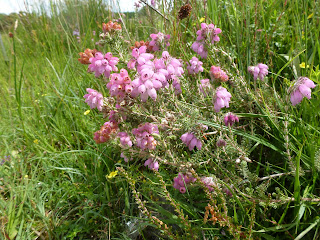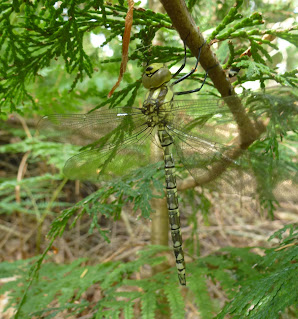Today’s event was inspired partly by bringing some Honeyguiders together for Lyn, visiting from Cambridgeshire, and partly by happy memories of the same event a year ago [Buxton Heath and Holt Lowes, 2 July 2021]. Same places, but a rather earlier summer this year with wildlife that was sometimes different as a result.
The
star species at Buxton Heath is silver-studded blue butterfly. On a day of
rather changeable weather, would they be on show? In the end it was
straightforward as there were several that were easy to see on the bell heather
very near to the car park. The heatwave in June meant that they were towards the
end of their season, and some were looking quite tatty. Happily, we did find
one where the ‘silver studs’ showed well, especially looking though the telescope.
Silver-studded blues: on the right hand butterfly above, you can just about make out the silvery-blue 'studs' in the dark spots above the orangey-brown marks.
Yellowhammers are getting scarcer in the countryside so two that perched in clear view were much enjoyed. We added linnet, reed bunting and stonechats a little later for some, and a willow warbler was singing from time to time, as well as more expected chiffchaffs and blackcaps.
Moving
into the boggy area, it seemed clearer of tall vegetation than a year ago, which is generally good, though there
were fewer orchids. But we did find a few marsh helleborines plus many pale pink
marsh orchids, always tricky to ID with certainty here with the range of
species and hybrids that occur. More certain was a mass of bog pimpernel, marsh
lousewort, lesser spearwort, tormentil, ragged robin, fen bedstraw and leaves
of marsh pennywort on mounds of sphagnum moss.Marsh helleborine.
We found an area that was dry enough for us to stand and overlook patches of open water over which several powder blue keeled skimmers moved to and fro, settling from time to time. With these were four-spotted chasers that were dipping into the water to deposit eggs.
 |
| Cross-leaved heath. |
 |
| Keeled skimmer, female. |
 |
| Jay feathers. |
As we drove north towards Holt there was a distinct change in the weather, including rain. We were glad to have packed lunches on Holt Country Park’s sheltered picnic benches, and to grab a hot drink from Hetty’s kiosk. That said, it couldn’t have rained at a more convenient time, and it began to clear up as soon as we were on the move.
 |
| Silver-washed fritillary. |
We checked out the buddleias in the car park where there was only a limited amount of flower and only a single red admiral. But no matter: we were just a short distance into the open woodland and, hey presto, four silver-washed fritillaries appeared on bramble flowers, looking pristine and freshly emerged. The golden wedding couple had followed us to Holt Country Park and, as they joined us, their sought-after butterfly appeared: a lovely white admiral, fluttering around its larval food plant, honeysuckle. The weather must have changed as a blackbird was sunbathing.Sunbathing blackbird.
There were more four-spotted chasers and several damselflies – and willow emerald egg-laying scars – at the big pond.
Out on Holt Lowes, we took our usual clockwise circuit. Once we’d reached the boggy areas that surround much of Holt Lowes, the search was on for alder buckthorn. Could we match last year’s experience of watching a brimstone laying eggs on its larval food plant? Well, yes and no. There were no adult butterflies, though we did see some eggs. Instead, it was all about caterpillars. Ann – no surprise there – was the first to find a green brimstone caterpillar, then Helen, then the rest of us – even me – got our eye in for finding our own. This is no easy feat as not only are they camouflaged by colour, they were along the mid-rib of alder buckthorn leaves, which also helps to hide them.
.jpg) |
| Play 'hunt the brimstone caterpillar' ... |
 |
| Alder buckthorn again, this time with a scorpionfly Panorpa communis or P. germanica. |
There were a few keeled skimmers, though fewer than at Buxton Heath. We couldn’t find any marsh helleborines – perhaps it’s a poor year for them. As at Buxton Heath, pink bog pimpernel was looking lovely, near which were the yellow flowers of marsh St John's-wort. Cheryl puzzled about the absence of buzzards, at which point one appeared. We heard a garden warbler, singing in unusually short bursts for this species, the ID confirmed by the Merlin song recognition App.
 |
| Marsh St John's-wort, Hypericum elodes. |
Brown china-mark moth, Holt Lowes.
We
passed the wood with the carpet of hair cap moss and continued to find more and
more alder buckthorn, and every damp area seemed to have more sundew leaves
than the last, many with slender spikes of flowers in bud. Round-leaved sundew, with pink-flowered bog pimpernel.
Back by the pond, a southern hawker flew past and settled in its characteristic vertical hanging position on a very small cypress tree in the gloom.
 |
| Southern hawker. |








No comments:
Post a Comment